In the bustling world of fashion, a transformative wave is sweeping across the industry. A fresh breed of visionaries, known as sustainable fashion designers, is rising to the fore, challenging the status quo and redefining style in an eco-friendly way. They’re not just designing clothes, they’re weaving a future where fashion doesn’t cost the earth.
So, let’s embark on this journey and explore the fascinating realm of sustainable fashion design, where style meets sustainability, and discover how these designers are making a fashionable difference.
Sustainable Fashion Designers

Delving deeper into this topic reveals sustainable fashion as a counter movement to fast fashion. In its core, it’s a design philosophy that values respect for the environment and human rights. Designers prioritize the use of eco-friendly materials, cut down on waste, and advocate for better work conditions. For instance, the use of organic cotton, hemp, or recycled polyester replaces harmful synthetic materials.
Waste reduction involves innovative designs that reuse materials, such as Eileen Fisher’s Renew program, which repurposes old garments into new designs. For work conditions, Stella McCartney sets an example by ensuring a high standard for labor rights in its supply chains.
Sustainable fashion champions a shift from the consumerist approach to one of conservation, transforming the way garments are produced, consumed, and discarded.
Pioneering Designers and Brands

Championing the sustainable fashion movement are designers who lead by example. Eileen Fisher, with her Renew program, is a prime pioneer. This program repurposes worn garments, extending their life cycle and reducing waste. Stella McCartney, another noteworthy figure, upholds labor rights, ensuring fair treatment for every worker in her supply chain. These designers don’t just use organic cotton and recycled polyester, they revolutionize their production processes to minimize environmental impact. Pact, a trailblazer, goes a step ahead, producing an eco-friendly line that is both comfortable and affordable. Offering organic cotton basics, Pact underscores that sustainable fashion isn’t a luxury; it’s a necessity.
Newcomers Shaping the Future
In the ever-evolving landscape of fashion, fresh-faced designers forge a new path, guided by sustainability. They follow the precedent set by seasoned names like Eileen Fisher and Stella McCartney, putting an innovative spin on the same principles. These change-makers marry form, function, and responsibility in their creations, amplifying the call for sustainable fashion in their nascent careers.

Among such innovators stands out Bruno Pieters, known for his brand Honest By, the first fashion company to provide complete transparency in its production chain. Pieters not only emphasizes organic and recycled materials but also manifests ethical labor practices. Another rising star, Bethany Williams, demonstrates eco-friendliness through the use of organic yarn spun from book waste, offering a unique edge to her creations while upholding sustainable values.
Impact on the Fashion Industry
The influence of sustainable fashion designers has led to a significant transformation in the industry. Establishments like Eileen Fisher and Stella McCartney fundamentally reshaped the way mainstream fashion operates, instilling practices that repel environmental hardship.
Fresh faces in the industry, such as Bruno Pieters and Bethany Williams, foster transparency, organic materials usage, and fair labor practices. These innovators, mentored by seasoned brands, steer the industry towards a more sustainable trajectory where eco-friendly practices embed themselves within design philosophies.
Consumer Role in Promoting Sustainability
It’s clear that sustainable fashion designers, both established and emerging, are paving the way towards a greener industry. Their commitment to eco-friendly practices, fair labor, and transparency is transforming fashion’s landscape. Yet, the power to truly revolutionize the industry lies in the hands of consumers. Their choices can propel the movement further by supporting these designers and opting for sustainable clothing. By valuing and investing in sustainable fashion, consumers can make a profound impact, encouraging more brands to follow suit. This collective effort can ensure that the fashion industry continues to evolve in a way that respects and protects our planet. It’s a shared responsibility that can lead to a brighter, more sustainable future.

